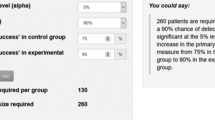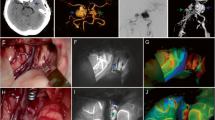Abstract
The primary aim of this study is to assess the value of intraoperative near-infrared indocyanine green videoangiography (ICGA) during intracranial aneurysm surgery. Altogether, 129 patients harboring 152 intracranial aneurysms were recruited in this study between March 2007 and December 2008 and the clinical data were retrospectively analyzed. Intraoperative ICGA was performed to examine the completeness of the aneurysm clipping and the patency of the parent arteries in all cases. The intraoperative findings were compared with that of postoperative digital subtraction angiography (DSA). On all of the patients, 276 successful ICGA investigations were performed intraoperatively. The image quality and resolution were excellent, allowing real-time assessment of the cerebral circulation. Indocyanine green (ICG) angiographic results could be divided into arterial, capillary, and venous phases, comparable to those observed with postoperative DSA. In all cases, the postoperative angiographic results corresponded to the intraoperative ICGA findings. In three cases, the information provided by intraoperative ICG angiography significantly changed the surgical procedure. Intraoperative ICG videoangiography may be a useful tool in real-time evaluation of the aneurysm clipping. Its simplicity and easy reproducibility all suggest it to be carried out as a routine procedure during aneurysm surgery.




Similar content being viewed by others
References
Greenberg MS (2006) Aneurysms. In: Greenberg MS (ed) Handbook of neurosurgery, 6th edn. Thieme Medical Publishers, New York, p 781
Akdemir H, Oktem IS, Tucer B, Menku A, Basaslan K, Gunaldi O (2006) Intraoperative microvascular Doppler sonography in aneurysm surgery. Minim Invasive Neurosurg 49:312–316
Horiuchi K, Suzuki K, Sasaki T, Matsumoto M, Sakuma J, Konno Y, Oinuma M, Itakura T, Kodama N (2005) Intraoperative monitoring of blood flow insufficiency during surgery of middle cerebral artery aneurysms. J Neurosurg 103:275–283
Neuloh G, Schramm J (2004) Monitoring of motor evoked potentials compared with somatosensory evoked potentials and microvascular Doppler ultrasonography in cerebral aneurysm surgery. J Neurosurg 100:389–399
Stendel R, Pietila T, Al Hassan AA, Schilling A, Brock M (2000) Intraoperative microvascular Doppler ultrasonography in cerebral aneurysm surgery. J Neurol Neurosurg Psychiatry 68:29–35
Zhao JZ, Wang S, Yuan G, Xu J, Jin M (2006) Intraoperative angiography in treatment of neurovascular disorders. Zhonghua Yi Xue Za Zhi 86:1044–1047
de Oliveira JG, Beck J, Seifert V, Teixeira MJ, Raabe A (2008) Assessment of flow in perforating arteries during intracranial aneurysm surgery using intraoperative near-infrared indocyanine green videoangiography. Neurosurgery 62:1300–1310
Raabe A, Beck J, Gerlach R, Zimmermann M, Seifert V (2003) Near-infrared indocyanine green video angiography: a new method for intraoperative assessment of vascular flow. Neurosurgery 52:132–139, discussion 139
Raabe A, Beck J, Seifert V (2005) Technique and image quality of intraoperative indocyanine green angiography during aneurysm surgery using surgical microscope integrated near-infrared video technology. Zentralbl Neurochir 66:1–6, discussion 7-8
Raabe A, Nakaji P, Beck J, Kim LJ, Hsu FP, Kamerman JD, Seifert V, Spetzler RF (2005) Prospective evaluation of surgical microscope-integrated intraoperative near-infrared indocyanine green videoangiography during aneurysm surgery. J Neurosurg 103:982–989
Feuerberg I, Lindquist C, Lindqvist M, Steiner L (1987) Natural history of postoperative aneurysm rests. J Neurosurg 66:30–34
Sindou M, Acevedo JC, Turjman F (1998) Aneurysmal remnants after microsurgical clipping: classification and results from a prospective angiographic study (in a consecutive series of 305 operated intracranial aneurysms). Acta Neurochir (Wien) 140:1153–1159
Macdonald RL, Wallace MC, Kestle JR (1993) Role of angiography following aneurysm surgery. J Neurosurg 79:826–832
Chiang VL, Gailloud P, Murphy KJ, Rigamonti D, Tamargo RJ (2002) Routine intraoperative angiography during aneurysm surgery. J Neurosurg 96:988–992
Popadic A, Witzmann A, Amann T, Doringer W, Fleisch M, Hafel C, Hergan K, Langle M (2001) The value of intraoperative angiography in surgery of intracranial aneurysms: a prospective study in 126 patients. Neuroradiology 43:466–471
Tang G, Cawley CM, Dion JE, Barrow DL (2002) Intraoperative angiography during aneurysm surgery: a prospective evaluation of efficacy. J Neurosurg 96:993–999
Vitaz TW, Gaskill-Shipley M, Tomsick T, Tew JM Jr (1999) Utility, safety, and accuracy of intraoperative angiography in the surgical treatment of aneurysms and arteriovenous malformations. AJNR Am J Neuroradiol 20:1457–1461
Barrow DL, Boyer KL, Joseph GJ (1992) Intraoperative angiography in the management of neurovascular disorders. Neurosurgery 30:153–159
Martin NA, Bentson J, Vinuela F, Hieshima G, Reicher M, Black K, Dion J, Becker D (1990) Intraoperative digital subtraction angiography and the surgical treatment of intracranial aneurysms and vascular malformations. J Neurosurg 73:526–533
Hope-Ross M, Yannuzzi LA, Gragoudas ES, Guyer DR, Slakter JS, Sorenson JA, Krupsky S, Orlock DA, Puliafito CA (1994) Adverse reactions due to indocyanine green. Ophthalmology 101:529–533
Author information
Authors and Affiliations
Corresponding author
Additional information
Comments
Guiseppe Lanzino, Rochester, USA
Microscope-integrated near-infrared indocyanine green (ICG) angiography is one of the main recent advances in vascular neurosurgery. It allows for intraoperative visualization of the vessels in the microscope field and is routinely utilized in aneurysm surgery to assess the degree of aneurysm occlusion, rule out parent vessel compromise, and assess patency of perforators. More recently, the role of ICG angiography has also been evaluated in brain AVM surgery, in which it may help in separating feeding arteries from draining veins. ICG also is useful in assessing the intraoperative patency of EC-IC bypasses.
In line with other studies, Wang and coworkers have confirmed the effectiveness of ICG intraoperative angiography in providing immediate feedback during aneurysm surgery. In many patients, the availability of this tool has obviated the need for intraoperative catheter-based angiography, though a limitation of ICG angiography is that it is only useful in the assessment of brain vessels along the line of sight of the microscope. This can be a major limitation especially in very large and giant aneurysms where important branches or perforators may be obscured by the mass of the aneurysm itself and not adequately visualized with this technique. Other limitations of ICG angiography include the inability to provide feedback on the amount of flow through the parent vessel or branches emanating from the aneurysm. As suggested by one case in the present report, the information provided by ICG angiography is also limited in heavily calcified vessels.
Rights and permissions
About this article
Cite this article
Wang, S., Liu, L., Zhao, Y. et al. Evaluation of surgical microscope-integrated intraoperative near-infrared indocyanine green videoangiography during aneurysm surgery. Neurosurg Rev 34, 209–215 (2011). https://doi.org/10.1007/s10143-010-0305-2
Received:
Revised:
Accepted:
Published:
Issue Date:
DOI: https://doi.org/10.1007/s10143-010-0305-2




